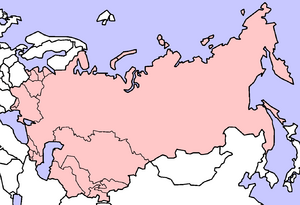Union republic: Difference between revisions
Jump to navigation
Jump to search
Harrystein (talk | contribs) m ('"Soviet republic" redirects here. For the political concept, see Soviet democracy.') |
Harrystein (talk | contribs) (added map of union republics) |
||
| Line 1: | Line 1: | ||
{{redirect|Soviet republic|the political concept|Soviet democracy}} | [[File:soviet Union Map.png|thumb|right]]{{redirect|Soviet republic|the political concept|Soviet democracy|Map of the Union Republics of the USSR as they existed until 1991.}} | ||
The '''union republics''' were the administrative units and semi-autonomous members of the [[Union of Soviet Socialist Republics]]. Their number varied over time, but there were fifteen at the time of the [[Collapse of the USSR|Union's dissolution]] in 1991, when they exercised their right to secede according to the Soviet constitution. {{cn}} | The '''union republics''' were the administrative units and semi-autonomous members of the [[Union of Soviet Socialist Republics]]. Their number varied over time, but there were fifteen at the time of the [[Collapse of the USSR|Union's dissolution]] in 1991, when they exercised their right to secede according to the Soviet constitution. {{cn}} | ||
==History== | ==History== | ||
Revision as of 19:42, 18 August 2023
The union republics were the administrative units and semi-autonomous members of the Union of Soviet Socialist Republics. Their number varied over time, but there were fifteen at the time of the Union's dissolution in 1991, when they exercised their right to secede according to the Soviet constitution. [citation needed]
History
The Russian Empire had absorbed dozens of nationalities in its existence, especially during the rapid expansion of the 19th century. Joseph Stalin wrote Marxism and the National Question in 1913 concerning how a socialist government would deal with the issue, and his ideas are considered to be an influence on the national policy of the eventual Soviet Union.
List
The fifteen republics as they stood in 1991 were as follows:
- Armenian Soviet Socialist Republic
- Azerbaijan Soviet Socialist Republic
- Byelorussian Soviet Socialist Republic
- Estonian Soviet Socialist Republic
- Georgian Soviet Socialist Republic
- Kazakh Soviet Socialist Republic
- Kirghiz Soviet Socialist Republic
- Latvian Soviet Socialist Republic
- Lithuanian Soviet Socialist Republic
- Moldavian Soviet Socialist Republic
- Russian Soviet Federative Socialist Republic
- Tajik Soviet Socialist Republic
- Turkmen Soviet Socialist Republic
- Ukrainian Soviet Socialist Republic
- Uzbek Soviet Socialist Republic
